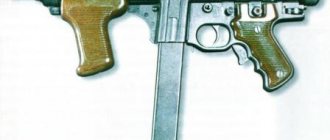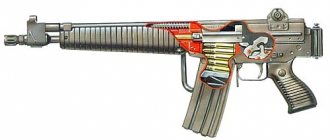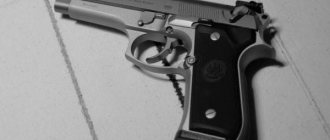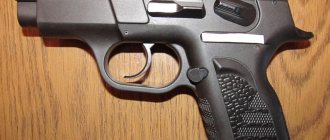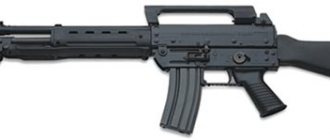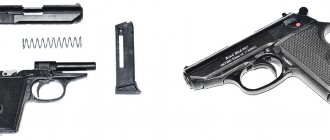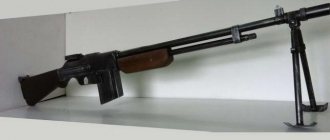Range Report: Beretta model 1934
This pistol is well known to fans of Soviet cinema, but few people know that they wrote about it in the reports of the shooting range long before it appeared on the screens
Before the start of World War II, Soviet military experts were quite keenly interested in Italian military equipment, but for the most part with an emphasis on naval topics. The pinnacle of this cooperation was the purchase of the Blue Cruiser, the leader of the Tashkent destroyers, built by Soviet order in Livorno. At the same time, we bought an Italian 100 mm universal gun.
The smaller Italian land models did not impress the Soviet purchasing commissions. About the same thing happened with those who reached or drove to the USSR under their own power. The Italian units on the flank of Paulus's army were left out of the first attack; their turn came after the Romanians, in December 1942. Well, after the Stalingrad defeat, no one was seriously interested in the Italians on our front. So it is not surprising that at the GAU shooting range they found time for weapons with the inscription “made in Italy” only in 1950.
First on the list for examination was a pistol listed as a “9mm Beretta Model 1934 Self-Loading Pistol.”
According to Soviet testers, it was
“developed for a 9 mm shortened cartridge” and “the design is similar to the well-known 9 mm semi-automatic pistol “Beretta” model 1923 chambered for the Parabellum cartridge.”
It is worth noting here that one of the M1934 variants was actually chambered for the 9x17 mm cartridge, but most likely they did not try to shoot the mentioned M1923 model at the training ground. Otherwise, testers could be convinced that automatic blowback systems chambered for the Georg Luger cartridge have a poor and short-lived life. The Italians used the Glisenti cartridge for the M1923 - essentially the same 9x19 mm, but with a weakened charge.
“The pistol of the 1934 model has smaller dimensions and some unprincipled changes in individual parts: the shape of the handle has been improved, the cheeks of the handle are made of plastic instead of stamped metal ones, the shape of the trigger rod has been changed, a rear sight has been installed on the casing similar to the rear sight of the 7.62 mm pistol of the 1933 model (SSR ), and also the steel grade of the barrel and the bolt casing was replaced, which can be concluded by comparing the colors of the oxide coating.”
It is interesting that, judging by the results of the inspection, the pistol manufactured in 1949 came to the USSR through second hands, most likely South Slavic hands.
“On the back of the pistol grip there is a non-factory engraving in the form of a five-pointed star, around which are engraved the words: “Smrt fasizmu - Sloboda narodu.”
For comparison, serial Makarov and TT pistols were taken from the Soviet side. Of course, the Makarov was already a pistol of a much later design, but the Tula Tokarev was almost the same age as the Beretta. Of the three, the M1934 model turned out to be the smallest and lightest. But the descent force was a surprise for the testers - 5.5 kg for the Beretta versus 2.7 kg for the Makarov and 3 kg for the TT.
Due to the small number of cartridges, the test program had to be limited - the Italian pistol was passed only through dust, with lubricant and with dry parts after washing with gasoline. The Beretta withstood this stage quite well, earning a review: “the pistol’s automatic system is insensitive to the lack of lubrication and dusty parts.”
The pistol performed much worse during shooting. At a distance of 25 meters, in three series of 10 shots, standing hand-held and sitting on a shooting bench, the testers “drew” from the M1934 heaps approximately twice as large as those of two domestic pistols - 23-24 cm. The main reason was considered the same great effort on descent. In addition, the shooters also had complaints about the sighting devices of the Italian pistol - the front sight turned out to be too wide and, when aiming, covered the rear sight slot.
The lack of self-cocking in the Beretta was noted as a disadvantage in comparison with the Makarov.
In general, the Beretta did not make much of an impression on Soviet officers. As a positive side of the design, they noted the absence of leaf springs in the pistol and the “relatively simple technology for manufacturing parts.” However, this simplicity should have come back to haunt users, since complete disassembly and assembly of the Beretta required special tools and 2-3 times more time than domestic models. They decided to highlight one point related to the assembly separately in the report:
“The trigger assembly - the trigger rod, which has a bend supported by a spring - also causes inconvenience during assembly. Experience shows that parts of this kind are often lost when disassembling and assembling weapons.”
We can say that in the USSR the Beretta, in a sense, lost the competition that it had long ago won in its homeland. One of the reasons for the appearance of the M1934, or rather the next modification of the M1915 pistol, was the interest shown by the Italian army... in the German “Walter PP” as the main service pistol. However, based on the test results, the military still chose Model 34 (the Navy and Air Force ordered the M1935 - the same pistol, but in 7.65 mm caliber). And, in general, they were right - the pistol remained in service with the Italian army for a very long time - according to the author, it was issued to military personnel during the conflict in the former Yugoslavia in the 90s of the last century, and the total production of the M1934 exceeded a million copies.
And in conclusion, let us recall that this pistol was very familiar to a huge number of Soviet moviegoers. It was the M1934 Beretta with the characteristic spur that was given to Semyon Gorbunkov in the film “The Diamond Arm.” It should be noted that both the anti-aircraft gunner Nikulin and the attack pilot Vladimir Gulyaev handle the pistol on the screen deliberately carelessly. However, this does not prevent Gorbunkov from making one of the most spectacular shots from the Beretta in the entire history of Soviet cinema.
Pistol modifications
Over 150 different variants, including unofficial ones, have been produced based on the Beretta 92.
Weapons are produced in a wide variety of modifications, differing in size, design of the fuse and trigger, surface treatment, types of materials, the presence of a silencer and other devices.
- Beretta 92S is the first modification of the 92 model. A safety guard has been added to the bolt for a safe release of the trigger
- Beretta 92SB - new semi-cocked hammer and automatic firing pin lock
- Beretta 92SB-C - compact version of the 92SB
- Beretta 92F - development of the 92SB model, created as part of the American XM9 competition
- Beretta 96 is a modification of the 92F for the American police market chambered for the .40SW cartridge. The magazine capacity is 11 rounds. Widely used in the police, as well as in the US border guards, and is successful in the civilian market
- Beretta 92 Vertec is a modification aimed at the US arms market.
Video about the pistol
In May 1915, Italy enters the First World War. In the first months, there is a need for reliable close combat weapons - pistols. The Glisenti M 1910 pistol, similar to the German parabellum, did not satisfy this need. Then Pietro Beretta comes onto the scene with its own take on the design of a pistol.
This is the look of the 9 mm M1915 model, which quickly replaced all analogues and won a place in the holster of the Italian army. The accuracy and reliability of the new weapon, which made history at the right moment, ensured the future of Beretta pistols for a long time.
Thus began the history of the family of Italian self-loading pistols, which has continued for more than a hundred years.
Design features of the Beretta 92 pistol
- The operation scheme of the Beretta 92 automatic is made due to the recoil of the short stroke of the barrel. A complete disassembly of the pistol will include 65 parts. There is a return spring located under the barrel. The barrel is locked when it rolls back longitudinally by engaging the bolt with a special larva swinging on an axis; it is placed between its lugs at the bottom of the barrel.
- The combat firing scheme looks like this. When fired, the bolt and barrel move back a couple of millimeters. A longitudinal spring-loaded rod bumps into a frame in the rear boss of the barrel. The swinging larva ceases to interact with the protrusion of the frame; under the influence of the rod, it turns and lowers its rear part. The barrel, after the interaction of the frame and the cylinder with the rod, disengages from the bolt, stopping by the frame. The bolt ejects the cartridge case, continuing to move, compresses the return spring, cocking the hammer, and then compresses the mainspring. The bolt, under the pressure of a compressed return spring, moving forward, forces the cartridge into the chamber, pushing the barrel. The spring-loaded rod returns back and releases the larva. The protrusion of the frame, as well as the end of the spring resting against it, raises the larva. The lateral protrusions of the larva extend into the vertical slots of the bolt. The cylinder is again engaged with the bolt. The gun is ready for the next shot.
- The trigger mechanism only became complete in the Beretta 92SB. The trigger had an open trigger and was double-action. The firing pin is spring-loaded, held in a position away from the primer, and is covered by a jumper from the hammer strike to the final phase of movement of the trigger.
Principle of operation
Before firing, the rear end of the return spring slightly raises the cylinder, its side protrusions engage with the longitudinal side slots located inside the bolt casing.
When fired, the bolt and barrel move back synchronously. The spring rod, hitting the frame, lowers the cylinder, the barrel disengages from the bolt: the first freezes, and the latter, moving, pushes the spent cartridge case to the right and cocks the hammer.
The currently compressed return spring pushes the bolt forward, resulting in:
- a new cartridge is sent into the chamber;
- the rod moves away from the locking larva;
- it again engages with the slots of the bolt, thereby preparing the pistol for a new shot.
The weapon is put on safety by moving the flag downwards, which safely releases the trigger with the sear and trigger rod disconnected. If there is ammunition in the chamber at this moment, to fire a self-cocking shot it is enough to move the flag up and pull the trigger. But in order to aim more accurately, you need to cock it.
Reloading by jerking the bolt is possible in any position of the safety.
When the magazine is empty, the shutter is delayed. It is enough to insert a full magazine and remove the delay, pulling the bolt back slightly, it sends the first charge into the chamber - the pistol is immediately ready to fire.
Pros Cons
Advantages:
- Large balanced weight from 870 to 950 grams (up to 1000) leads to a quick return to the line of sight;
- The increased distance between the front sight and the sight makes aiming easier;
- The fuse box is located on both sides;
- “Licked” structural elements do not cling when pulled out.
Flaws:
- The immodest size makes concealed carry difficult;
- Firing high power cartridges reduces durability;
- The bulky handle is inconvenient for a person with small palms and fingers.
Since the pistol’s feature is an open bolt with a view of the barrel, the following disadvantages arise:
- Possibility of getting burned by a hot barrel;
- Increased contamination of the internal parts of the gun.
Today the Pietro Beretta company is called Fabbrica d'Armi Pietro Beretta Gardone and is not going to give up its place in the arms market, including pistols. The BU-9 Nano, an extremely compact concealed carry pistol, was recently released.
The latest development that has already appeared on the market is the Beretta APX multi-caliber pistol. The Beretta story definitely won’t end there, we’ll wait and see.
How to play with Two Berettas
As you already understood, the two handsome men have a total supply of ammunition in two magazines - 30 rounds. Therefore, we strongly advise you to find cover when the bullets run out, or the opportunity to escape from the enemy. Due to the long recharge time, it takes time during which you are very vulnerable. Consider this fact; According to the classics of things, getting hit in the head gives a significant effect. Therefore, advising to shoot in the head is our #1 commitment; If you plan to play with this weapon (more often this happens without a plan), then before the game try to shoot and practice on bots or DesMatch. Since you will need good aim (targeting). Against armor, only a hit to the head will be effective. Therefore aim is your everything; At distances, shooting with Berettas is not very revealing. If you manage to kill an enemy, it will be very lucky, especially if he has armor. Try in every possible way to create situations in which your opponents will be as close to you as possible; One interesting tactic for two Berettas is to buy them in the pistol round. And yfukj fly at the enemy constantly shooting at the positions in which they will stand
This makes sense, because the number of cartridges will allow you to continue the attack, and in the event of an accidental hit to the head, this will lead to the capture of the zone; Pay attention to the spread of bullets, this is very important to understand when shooting: This pair of hurricanes can also be useful as a spare device. In other words, if you run out of cartridges, then without reloading the main weapon, get the Beretta; When the enemy has a high probability of purchasing armor, we do not recommend playing against armor with two Berettas. The chance of killing more than 1 enemy is very small, because the damage through the armor is weak; If your main weapon is an AWP (leg shot), Scout, or something rapid-fire, then the double beretta is a good option for finishing off players; If your opponent decides to use such a gun against you, then calmly try to maximize the distance between you
This will allow you to maintain maximum advantage against two Berettas; Also, always try to listen carefully to players' cooldowns. Many inexperienced opponents often reload (out of habit) all devices after a normal firefight. At this moment, we recommend attacking him, since reloading pistols takes a very long time;
Good positions are the key to your success against such a device. It penetrates walls very poorly, as well as wooden shelters. Constantly moving around is good form and will greatly add to your advantage.
Interesting facts about Dual Berettas
- Until 2015, this was the only device in the game that can be used with two hands. Nowadays there are also butcher knives;
- It’s stupid, but true: in cs 1.6 the first shot was always fired from the right hand, in cs:go it happens the other way around;
- The kill counter counts the total number from two pistols, and not from the one on which the counter itself is located (StatTrak);
- In the game, an architect was misspelled on the pistol (PIETA BARDOTTA). This mansion is related to not violating copyright;
- It’s strange, but if you turn on the cheat for endless ammo, then one pistol fires;
- In 2016, with the next update, the sounds were also changed.
- In 2014, when the NiP team was at the peak of its form, it allowed them to mock their opponents and the entire team was bought by the cowboys. And they made a cowboy snake:
And stay on top of eSports with GOCSGO.NET
THX
TTX:
- Weight: 0.9 kg
- Length: 200 mm
- Barrel length: 120 mm
- Cartridge: 9×21 mm SP 10
- Magazine: 18 rounds
- Initial bullet speed: 410 m/s
- Sighting range: 100 m
In a soldier's holster: in Russia.
Design engineer of TsNIITochmash, Klimov, Petr Ivanovich Serdyukov, made a huge contribution to the development of small arms and special technical equipment on the territory of the Russian Federation. Fourteen developments have been adopted, but how many ideas remain in draft form. The first appearance of our hero "SPS" was officially reported in 1991. In 2003, the Ministry of Defense and the Ministry of Internal Affairs already began to use a modern model of the Serdyukov self-loading pistol (aka SR-1, aka “Vector” or “Gyurza”), developed on the basis of the Walther P38.
The model is designed to defeat an enemy using class II personal protective equipment (anti-fragmentation vests). The gun has been successfully tested in different climatic conditions from -50 °C to + 50 °C. The pistol has repeatedly demonstrated its performance characteristics in foreign countries; experts agree that the SPS is the most penetrating pistol in the world.
For collectors and hobbyists
Since the Beretta 92 is a worldwide trend, it is understandable that there were people willing to produce copies of this type of pistol, thereby pleasing fans and collectors. Thus, the production of the Glacier Beretta 92 pistol, an exact copy of the combat Beretta 92, but not a firearm, but a pneumatic one, has long been put into mass production.
This is an exact copy of its combat counterpart - in every detail (except perhaps for the bolt stop, which has a purely decorative meaning). It is clear that with this approach, the pneumatic analogue is considered one of the best examples of pneumatic weapons in the world. It is made entirely of metal, its weight is the same as a combat pistol, its internal structure and disassembly is also exactly the same, it has a double action trigger, and in addition, it can also be fired in bursts.
Equipment
The model is not equipped with a large number of related accessories and comes in an ascetic plastic case. The kit includes a magazine, a cleaning rod, a hex key for adjusting the hop-up and instructions with a warranty card.
A distinctive feature is a very detailed specification in which all parts are described and numbered, making them easy to find if necessary.
The cleaning rod is combined with a fast loading device, which is a hollow tube. To load the magazine, balls are poured into the tube and pushed into its neck with a cleaning rod.
This speeds up the reloading process, which is important when the magazine capacity is small compared to hopper systems
